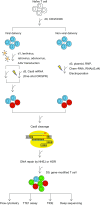Advancing chimeric antigen receptor T cell therapy with CRISPR/Cas9
- PMID: 28434148
- PMCID: PMC5563282
- DOI: 10.1007/s13238-017-0410-x
Advancing chimeric antigen receptor T cell therapy with CRISPR/Cas9
Abstract
The clustered regularly interspaced short palindromic repeats (CRISPR)/CRISPR-associated 9 (CRISPR/Cas9) system, an RNA-guided DNA targeting technology, is triggering a revolution in the field of biology. CRISPR/Cas9 has demonstrated great potential for genetic manipulation. In this review, we discuss the current development of CRISPR/Cas9 technologies for therapeutic applications, especially chimeric antigen receptor (CAR) T cell-based adoptive immunotherapy. Different methods used to facilitate efficient CRISPR delivery and gene editing in T cells are compared. The potential of genetic manipulation using CRISPR/Cas9 system to generate universal CAR T cells and potent T cells that are resistant to exhaustion and inhibition is explored. We also address the safety concerns associated with the use of CRISPR/Cas9 gene editing and provide potential solutions and future directions of CRISPR application in the field of CAR T cell immunotherapy. As an integration-free gene insertion method, CRISPR/Cas9 holds great promise as an efficient gene knock-in platform. Given the tremendous progress that has been made in the past few years, we believe that the CRISPR/Cas9 technology holds immense promise for advancing immunotherapy.
Keywords: CRISPR/Cas9; T lymphocytes; adoptive immunotherapy; chimeric antigen receptor; gene therapy.
Figures
Similar articles
-
CRISPR/Cas9 and CAR-T cell, collaboration of two revolutionary technologies in cancer immunotherapy, an instruction for successful cancer treatment.Hum Immunol. 2018 Dec;79(12):876-882. doi: 10.1016/j.humimm.2018.09.007. Epub 2018 Sep 24. Hum Immunol. 2018. PMID: 30261221 Review.
-
Applications and advances of CRISPR-Cas9 in cancer immunotherapy.J Med Genet. 2019 Jan;56(1):4-9. doi: 10.1136/jmedgenet-2018-105422. Epub 2018 Jul 3. J Med Genet. 2019. PMID: 29970486 Review.
-
The application of CRISPR-Cas9 genome editing tool in cancer immunotherapy.Brief Funct Genomics. 2019 Mar 22;18(2):129-132. doi: 10.1093/bfgp/ely011. Brief Funct Genomics. 2019. PMID: 29579146 Review.
-
Applications and explorations of CRISPR/Cas9 in CAR T-cell therapy.Brief Funct Genomics. 2020 May 20;19(3):175-182. doi: 10.1093/bfgp/elz042. Brief Funct Genomics. 2020. PMID: 31950135 Free PMC article. Review.
-
Novelty in improvement of CAR T cell-based immunotherapy with the aid of CRISPR system.Hematol Transfus Cell Ther. 2024 Jan-Mar;46(1):58-66. doi: 10.1016/j.htct.2023.05.009. Epub 2023 Jul 12. Hematol Transfus Cell Ther. 2024. PMID: 37451978 Free PMC article. Review.
Cited by
-
Targeting uPAR by CRISPR/Cas9 System Attenuates Cancer Malignancy and Multidrug Resistance.Front Oncol. 2019 Feb 27;9:80. doi: 10.3389/fonc.2019.00080. eCollection 2019. Front Oncol. 2019. PMID: 30873379 Free PMC article.
-
Viral Vector-Based Gene Therapy.Int J Mol Sci. 2023 Apr 23;24(9):7736. doi: 10.3390/ijms24097736. Int J Mol Sci. 2023. PMID: 37175441 Free PMC article. Review.
-
CRISPR/Cas9 Gene-Editing in Cancer Immunotherapy: Promoting the Present Revolution in Cancer Therapy and Exploring More.Front Cell Dev Biol. 2021 May 20;9:674467. doi: 10.3389/fcell.2021.674467. eCollection 2021. Front Cell Dev Biol. 2021. PMID: 34095145 Free PMC article. Review.
-
Role of tumor microenvironment in cancer progression and therapeutic strategy.Cancer Med. 2023 May;12(10):11149-11165. doi: 10.1002/cam4.5698. Epub 2023 Feb 21. Cancer Med. 2023. PMID: 36807772 Free PMC article. Review.
-
Universal CARs, universal T cells, and universal CAR T cells.J Hematol Oncol. 2018 Nov 27;11(1):132. doi: 10.1186/s13045-018-0677-2. J Hematol Oncol. 2018. PMID: 30482221 Free PMC article. Review.
References
Publication types
MeSH terms
Substances
LinkOut - more resources
Full Text Sources
Other Literature Sources
Research Materials
Miscellaneous


